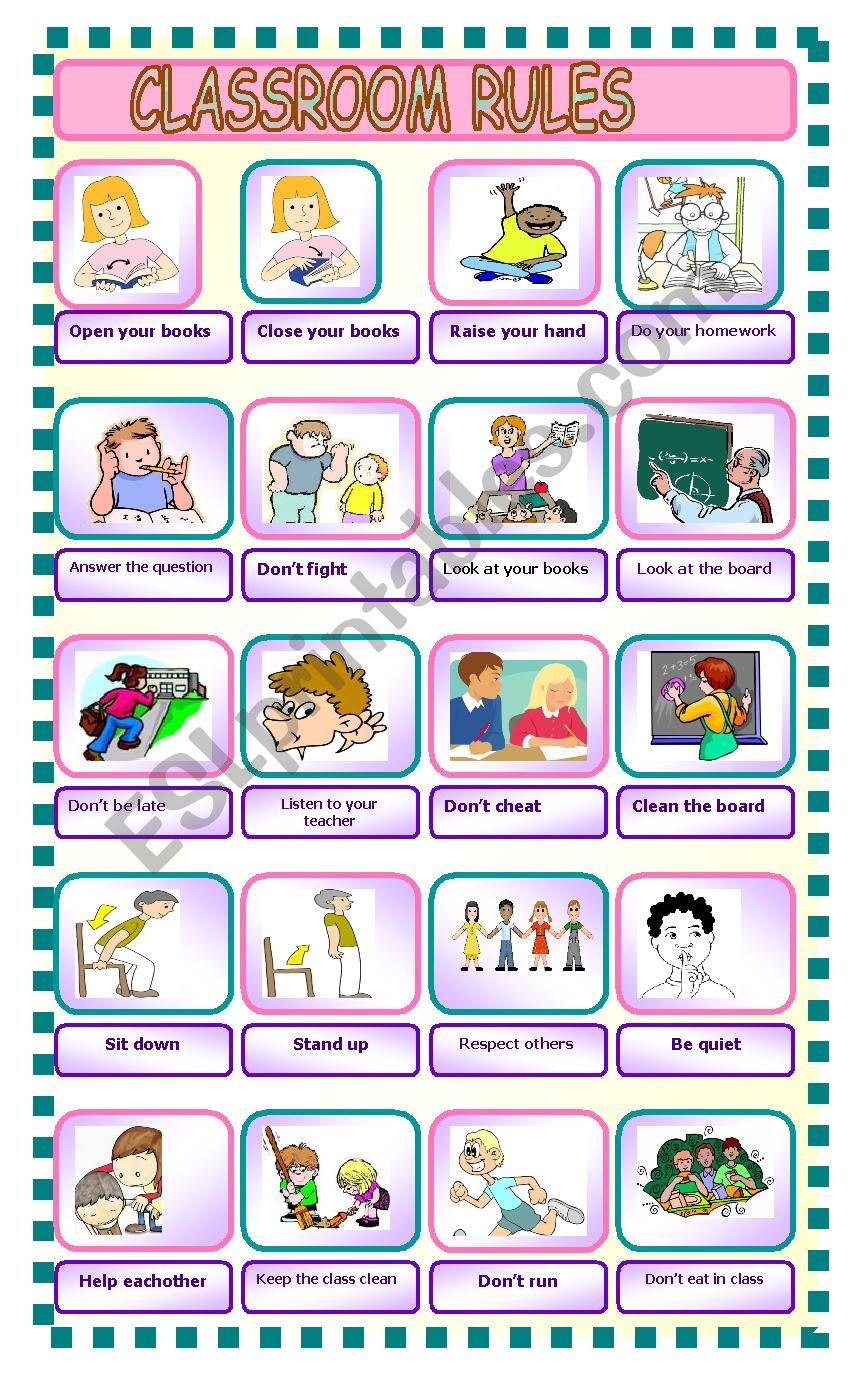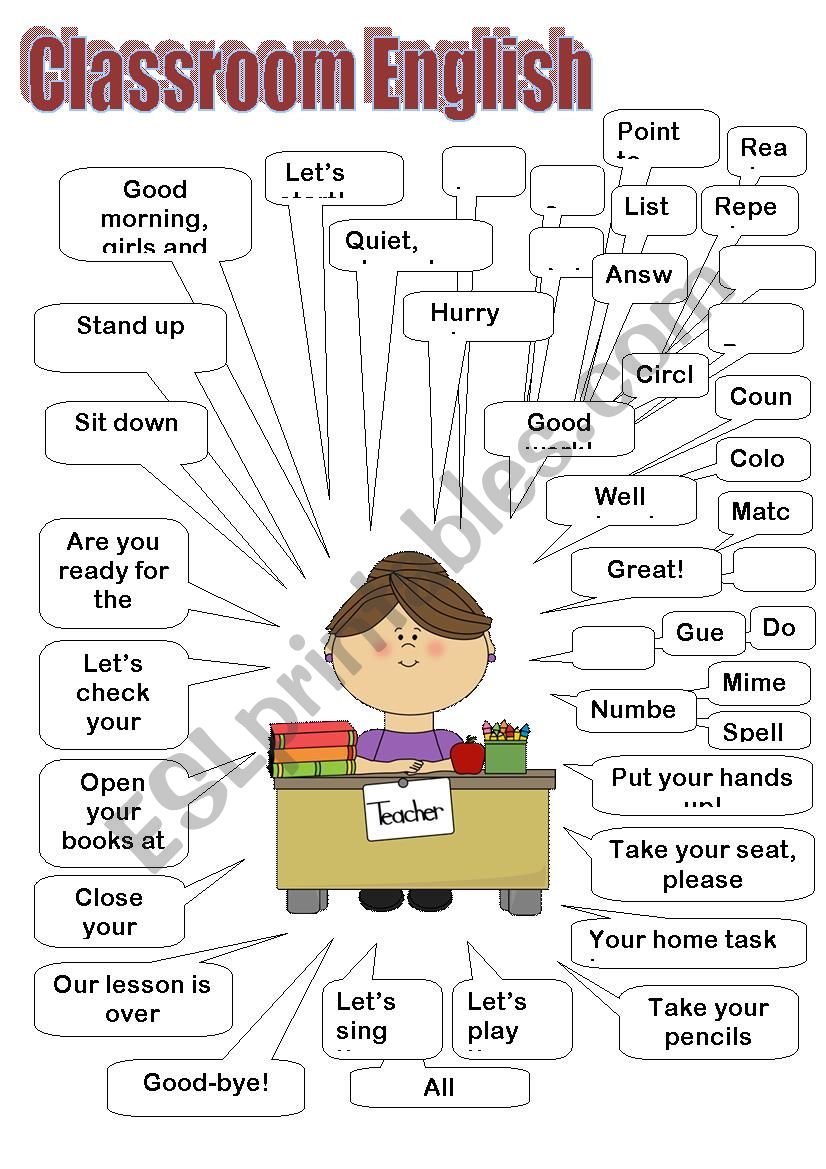
The Indispensable Role of ESL Classroom Management Printables Worksheets in Creating Effective Learning Environments
Effective classroom management is the bedrock of successful teaching and learning, especially in an English as a Second Language (ESL) setting. The unique challenges of an ESL classroom – diverse linguistic backgrounds, varying levels of English proficiency, cultural differences, and potential student anxiety – demand a proactive and well-structured approach. In this context, ESL classroom management printables worksheets emerge as invaluable tools, offering visual, structured, and consistent support that benefits both teachers and students. Far from being mere administrative aids, these printables are essential for fostering a predictable, supportive, and engaging learning environment where language acquisition can thrive.
Why Printables are Crucial for ESL Classroom Management
The rationale behind utilizing printables in ESL classroom management is deeply rooted in pedagogical principles. ESL learners, by definition, are navigating a new language. This language barrier can complicate understanding verbal instructions, rules, and expectations. Printables provide:

- Visual Reinforcement: Many ESL learners are visual learners. Seeing rules, schedules, or task instructions in written form, often accompanied by pictures or symbols, significantly enhances comprehension and retention compared to auditory instructions alone.
- Consistency and Clarity: Printables ensure that expectations are communicated consistently every time. A printed rule chart doesn’t change its wording or tone, reducing ambiguity and promoting a stable environment.
- Language Scaffolding: Well-designed printables can embed target language, providing sentence frames for requests, polite expressions, or descriptive vocabulary related to classroom routines. This incidental language exposure aids in language acquisition.
- Reduced Cognitive Load: When students don’t have to constantly translate or interpret verbal cues, their cognitive resources are freed up to focus on learning the subject matter and practicing English.
- Increased Autonomy and Responsibility: Printables empower students to take ownership of their learning and behavior. A student can refer to a printed checklist for a task or a behavior chart to monitor their progress, reducing constant reliance on the teacher.
- Bridging Communication Gaps: For students with limited English, printables can serve as a universal language, conveying meaning through visuals and simple text that might otherwise be lost in translation during verbal exchanges.




These benefits underscore why integrating a range of ESL classroom management printables worksheets is not just an option, but a strategic necessity for any ESL educator aiming for an organized, productive, and student-centered classroom.

Categories of Essential ESL Classroom Management Printables Worksheets
The utility of printables spans various aspects of classroom management. Here’s a breakdown of key categories and specific examples:

1. Behavior Management & Expectations
Establishing clear rules and consequences is paramount. For ESL learners, these need to be explicit and easily accessible.

- Classroom Rule Charts: Large, visually appealing charts outlining 3-5 core rules (e.g., "Listen actively," "Respect others," "Try your best"). Each rule should have a simple phrase, a corresponding picture, and perhaps a positive rephrasing.
- Behavior Contracts: Individualized agreements for students needing extra support, detailing specific behaviors to improve and rewards for success. Written in simple English with clear sections for student, teacher, and parent signatures.
- Reward Systems (Token Boards/Punch Cards): Printables where students earn tokens or punches for desired behaviors, leading to a predetermined reward. Visually trackable and highly motivating.
- Consequence Ladders/Charts: A visual representation of escalating consequences for breaking rules, ensuring fairness and predictability. Again, simple language and icons are key.
- Self-Reflection Worksheets: After an incident, a simple worksheet for students to reflect on what happened, how it impacted others, and what they could do differently next time. Provides language practice for expressing feelings and problem-solving.

2. Organizational & Routine Management
Helping students understand daily routines and expectations reduces anxiety and fosters independence.
- Daily Schedule Visuals: A large, prominent schedule with times and corresponding pictures/words for each activity (e.g., "Reading," "Math," "Lunch"). This helps students anticipate transitions and manage their time.
- Classroom Job Charts: A chart listing various classroom helper roles (e.g., "Pencil Monitor," "Door Holder," "Librarian") with student names or pictures assigned to them. Promotes responsibility and community.
- Supply Labels: Clear, bilingual (if appropriate) labels for classroom supplies (e.g., "Pencils," "Markers," "Scissors") with accompanying pictures. Helps students locate and return materials independently.
- Group Work Role Cards: For collaborative tasks, printable cards assigning specific roles (e.g., "Recorder," "Timekeeper," "Reporter," "Encourager") with simple descriptions of responsibilities. Ensures equitable participation.
- Transition Cues: Simple printable signs or cards (e.g., "Time to Clean Up," "Line Up," "Quiet Time") to signal transitions, especially useful for non-verbal cues.
3. Communication Aids & Scaffolding Language
Printables can directly support language acquisition related to classroom interactions.
- Classroom Language Posters/Cards: Posters displaying common phrases students might need (e.g., "May I go to the bathroom?", "I need help," "Can you repeat that?"). Students can point to them or read them aloud.
- Question/Comment Cards: Small printable cards with sentence starters for asking questions ("I wonder…", "What if…") or making comments ("I agree with…", "I respectfully disagree…").
- "Help Me" Cards/Signs: Simple cards students can discreetly place on their desk when they need assistance, signaling to the teacher without disrupting the class.
- Parent Communication Forms (Simplified): Templates for notes home regarding behavior, progress, or upcoming events, using clear, concise English and potentially space for translation or visual aids.
4. Engagement & Participation Boosters
Printables can make learning activities more structured and accessible, encouraging participation.
- Discussion Prompt Cards: Cards with open-ended questions or sentence starters to facilitate group discussions.
- Graphic Organizers: Visual frameworks (e.g., KWL charts, Venn diagrams, sequence charts) to help students organize thoughts, especially during reading or pre-writing activities. These reduce the cognitive load of language production, allowing focus on content.
- Peer Feedback Forms: Simple rubrics or checklists for students to provide constructive feedback to classmates on presentations or written work, focusing on specific criteria.
- Exit Tickets: Small printable slips at the end of a lesson for students to quickly answer a question, summarize a key concept, or ask a lingering question. Provides quick formative assessment.
5. Self-Assessment & Reflection Tools
Empowering students to reflect on their own learning and behavior is a key component of self-regulation.
- Daily/Weekly Self-Assessment Checklists: Printables where students can rate their effort, participation, or adherence to rules using simple scales (e.g., smiley faces, numbers).
- Learning Goal Trackers: Sheets where students can write down personal learning goals and track their progress over time.
- Portfolio Covers/Dividers: Printables to organize student work, fostering a sense of accomplishment and allowing students to see their progress.
Designing Effective ESL Classroom Management Printables Worksheets
The effectiveness of these printables hinges on their design. Consider these principles:
- Simplicity and Clarity: Use clear fonts, ample white space, and concise language. Avoid jargon or complex sentence structures.
- Visual Dominance: Incorporate relevant, culturally sensitive clip art, icons, or real-life photos to convey meaning, especially for beginners.
- Consistent Formatting: Maintain a consistent look and feel across different printables to create familiarity.
- Scaffolding Language: Intentionally embed target vocabulary, sentence frames, or simple grammatical structures that students can learn and use.
- Durability: Laminate frequently used printables (like rule charts or job charts) for longevity.
- Cultural Responsiveness: Ensure images and scenarios are inclusive and representative of your students’ backgrounds.
- Student Involvement: Where appropriate, involve students in creating or adapting printables, fostering a sense of ownership.
Implementing Printables for Maximum Impact
Simply having printables isn’t enough; their implementation is key.
- Introduce and Model: Don’t just put up a chart. Explicitly teach what each printable means and how to use it. Role-play scenarios.
- Consistent Reinforcement: Refer back to the printables regularly. When a student forgets a rule, point to the rule chart. When a student completes a task, check the checklist.
- Display Prominently: Place printables where they are easily visible and accessible to all students.
- Gradual Release of Responsibility: Initially, you might guide students heavily, but gradually allow them to use the printables independently.
- Review and Revise: Periodically assess if the printables are still effective. Are students using them? Are they meeting their intended purpose? Adjust as needed.
Beyond Management: The Holistic Benefits
While primarily designed for management, ESL classroom management printables worksheets offer a cascade of benefits that extend far beyond maintaining order. They contribute significantly to:
- Accelerated Language Acquisition: Through repeated exposure and practical application, students internalize classroom-specific vocabulary and functional language.
- Increased Student Autonomy: By providing clear guidelines and tools, printables empower students to manage their own learning and behavior, fostering independence.
- Reduced Teacher Burnout: A well-managed classroom reduces the constant need for verbal redirection, freeing up the teacher to focus on instruction and individual student needs.
- Positive Classroom Culture: Predictability, fairness, and clear expectations create a safe and supportive environment where students feel secure enough to take risks with their new language.
- Enhanced Parent-Teacher Communication: Simplified printables can bridge the communication gap with parents who may also have limited English proficiency, keeping them informed and involved.
Conclusion
In the dynamic and often complex world of ESL instruction, effective classroom management is not a luxury but a necessity. ESL classroom management printables worksheets stand out as incredibly versatile and impactful resources that address the unique linguistic and cultural needs of English language learners. From establishing clear behavioral expectations and streamlining routines to scaffolding language and fostering student autonomy, these printables are the silent workhorses that underpin a productive and harmonious learning environment.
By thoughtfully selecting, designing, and consistently implementing these visual and structured tools, ESL educators can transform their classrooms into predictable, engaging, and language-rich spaces where students feel secure, understand expectations, and are empowered to thrive. Ultimately, investing time in selecting or creating effective ESL classroom management printables worksheets is an investment in student success, teacher well-being, and the creation of truly effective learning environments.
